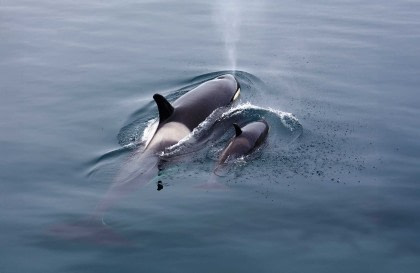Imagine for a moment that you are on an Arctic expedition and spot a woolly mammoth on land. This is something that has not been possible anywhere on earth for approximately 4,000 years, and the largest concentration of woolly mammoths died off 10,000 years ago. Now there are some scientists who say that it might be possible to bring these ancient elephant relatives back to life. If this were to actually happen, the woolly mammoths would need to be introduced to a habitat that is suited to their fur covered bodies, which makes the Arctic a natural choice. After all, these creatures thrived there more than 10,000 years ago, and it makes sense to theorize that they could find the same level of success today.
How is it Possible to Bring Woolly Mammoths to Life?
The blockbuster film “Jurassic Park” is based around the idea that DNA can be utilized to make any extinct creature live again. Although most people assumed that this was mostly nothing more than an idea that was developed by a creative science fiction writer, the reality is that it is theoretically possible to reintroduce any extinct species into the world with the right components.
In this specific situation, researchers have recently completed the entire genome sequence for woolly mammoths. On the surface, this might sound like nothing more than an opportunity to learn what happened that caused these creatures to become extinct in the first place. Perhaps this should be the only thing that scientists have in mind, but it is hard to imagine completing this type of work without wondering whether or not you should take the next step.
According to National Geographic, there is already a park put aside in Russia that would be perfect for housing the first woolly mammoths to walk the earth in 4,000 years. In other words, scientists are well on their way to turning science fiction into fact. If the proposed experiments come to fruition and prove to be successful, it is only a matter of time until these mammals are reintroduced to the Arctic.
Should Woolly Mammoths Stop Being Extinct?
It is difficult to make a prediction with any certainty regarding the implications of bringing an ancient creature into the modern world. Beth Shapiro, who is an evolutionary biologist, says there are many good reasons to bring back woolly mammoths such as increasing biodiversity, restoring ecosystems and scientific curiosity. Of course, it is also possible that the reintroduction of the woolly mammoth species could become extremely detrimental.
As herbivores, their preferred source of grassland food might no longer be available in our current climate conditions. Additionally, it is possible that adding too many woolly mammoths to an area at once could lead to the devastation of the local ecosystem. It is also interesting to consider which modern animals would become the woolly mammoths’ natural enemies. Would fighting between these species harm animals that are currently endangered?
What do We Know about Woolly Mammoths?
Woolly mammoths were first identified from their bones in 1796 by Georges Cuvier. It was quickly determined that these extinct mammals were once a species of elephant, and further research has helped paint a nice picture of what they once looked like. We know that woolly mammoths ranged from 2.7 to 3.4 meters (8.5 to 11 feet) tall, and they weighed up to 6.6 short tons. The closest living relative in terms of size is the male African elephant.
Their characteristic fur made them well-suited to colder climates, but they did not always live in areas such as the Arctic. Surprisingly, woolly mammoths can be traced back to Africa. They eventually migrated through Europe and Canada, and this is one of the species that survived the Ice Age. During that time, evolution helped the large mammals develop the necessary physical traits to thrive in the Arctic. Their pelt became thick, their ears grew smaller to diminish heat loss and it is also believed that they developed the counter-current blood system.
Most of these details have been ascertained by the amazingly well-preserved remains that have been found in the Arctic. In 2009, there was a lot of debate within the scientific community about whether or not the frozen samples of woolly mammoths and many other creatures could be used for cloning purposes. At that time, it was not easy to find a general consensus among researchers, but a lot has changed in just six years. Now it seems like many scientists believe it is possible, but the new debate is over whether doing so is actually ethical.
Ethical Issues Involving De-Extinction
Blood and flesh samples were taken during an autopsy that was performed on a preserved woolly mammoth known as Buttercup. The preservation was so good that a large amount of Buttercup’s blood was still accessible. The autopsy revealed that the mammal had given birth to at least eight calves, and it is also likely that she suffered from gallstones. Buttercup died in her 50s, and she has provided researchers with the building blocks to seriously consider making her species de-extinct.
There are many ethical issues that should be examined closely before anyone moves forward with bringing these ancient creatures into modern times. For example, is it right to revive a species that died out if scientists actually believe in survival of the fittest? On the other hand, many researchers believe that humans were one of the main contributing factors to the extinction of woolly mammoths. Does this mean it would be morally correct to reverse the damage that our human ancestors caused?
Regardless of which side of this debate you fall on, it is important to consider that woolly mammoths will need enough land and food to thrive, and they could also have a significant impact on reversing the overall decline in the global elephant population.
Can Humans and Woolly Mammoths Coexist?
Humans and woolly mammoths coexisted for centuries, so there is no reason to believe that we could not do the same thing again. Some of the earliest humans used woolly mammoth bones for creating weapons, and they were also hunted for food. This is the issue that has led some researchers to blame humans for the extinction of these creatures, but how do we know that people would not end up doing the same thing all over again? Even national parks that are supposed to offer protection to endangered species are not always capable of doing so, and poachers in Africa killed 100,000 elephants between 2010 and 2012. However, if the woolly mammoths could be given a greater level of protection, they would be able to peacefully coexist with us.
Arctic expedition participants would most likely love having the opportunity to see these ancient creatures in the flesh. Our Greenland trips are based around learning and observation, and this is exactly what the world needs if woolly mammoths are going to return. After all, when people are given a chance to see the majestic creatures within the Arctic region firsthand, it generally instills them with the desire to help conservation efforts. Therefore, if woolly mammoths ever return to the shores of the Arctic region, we will be thrilled to include them as one of the many diverse species that can be spotted from our ships.






